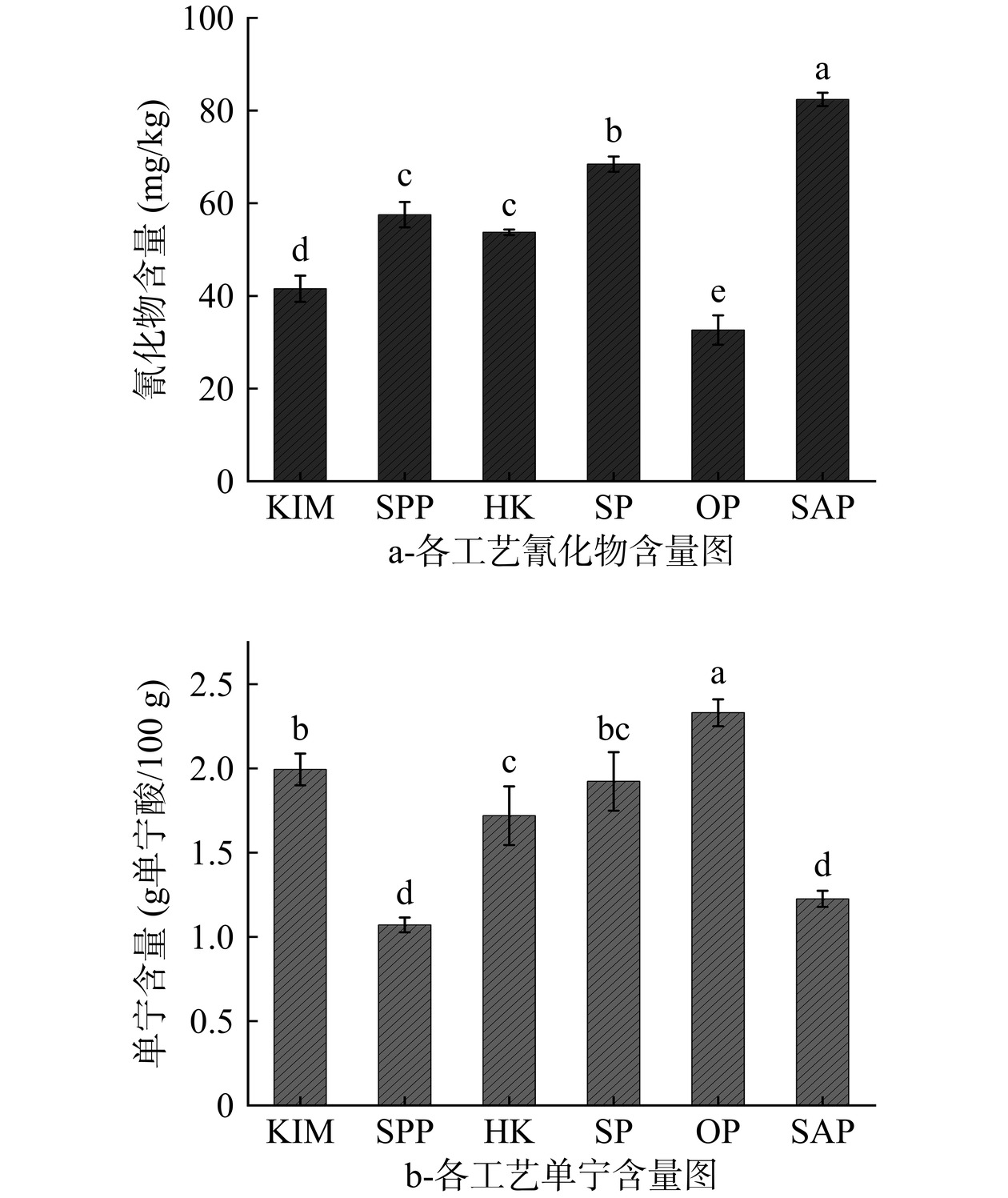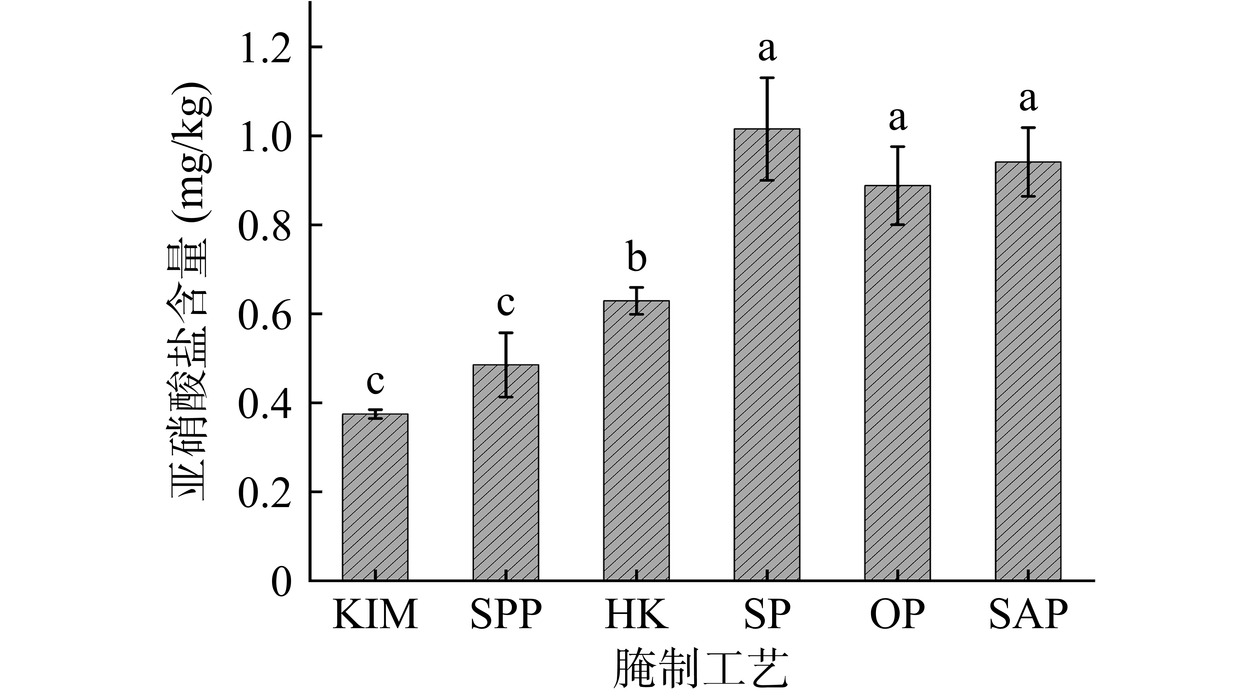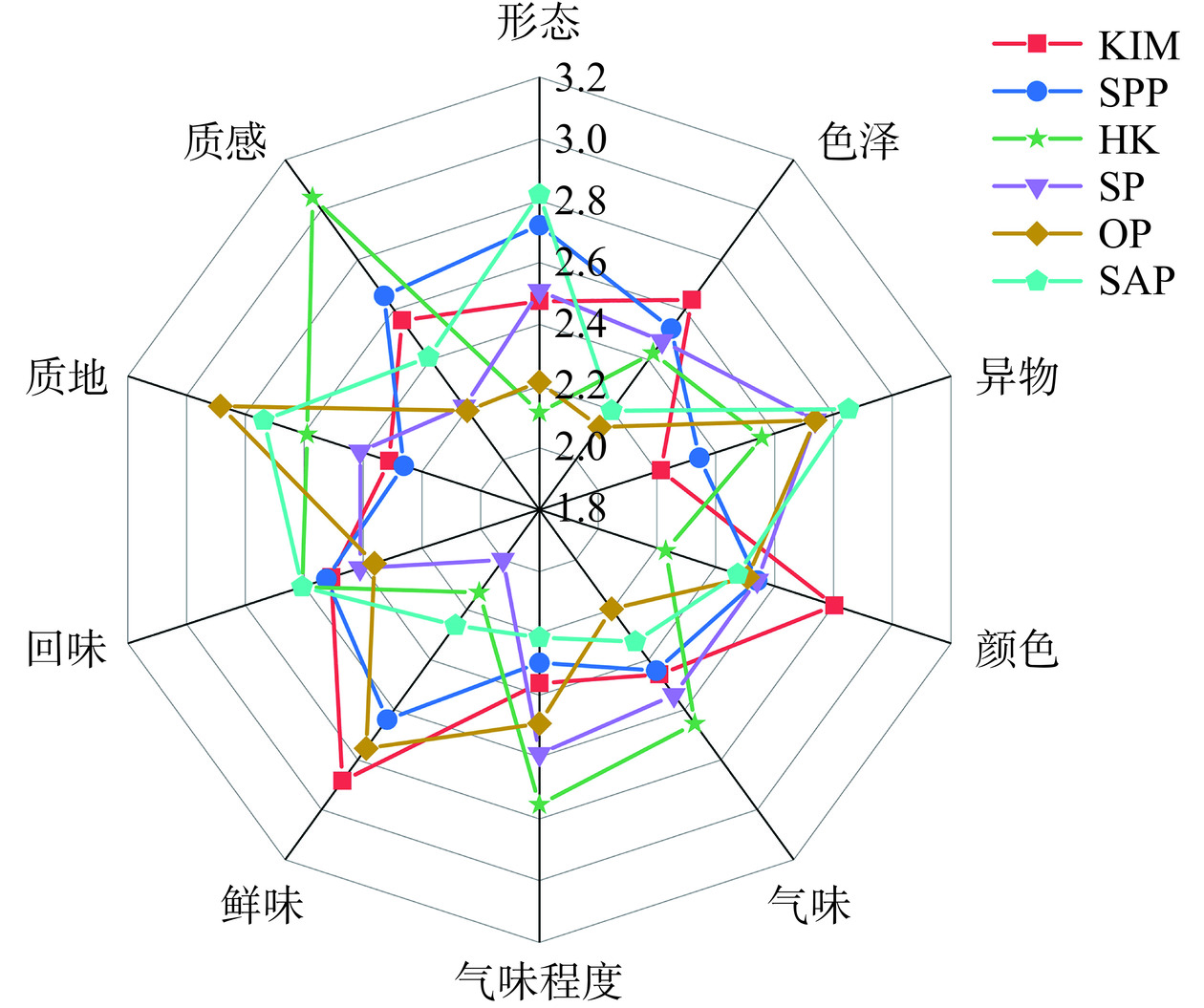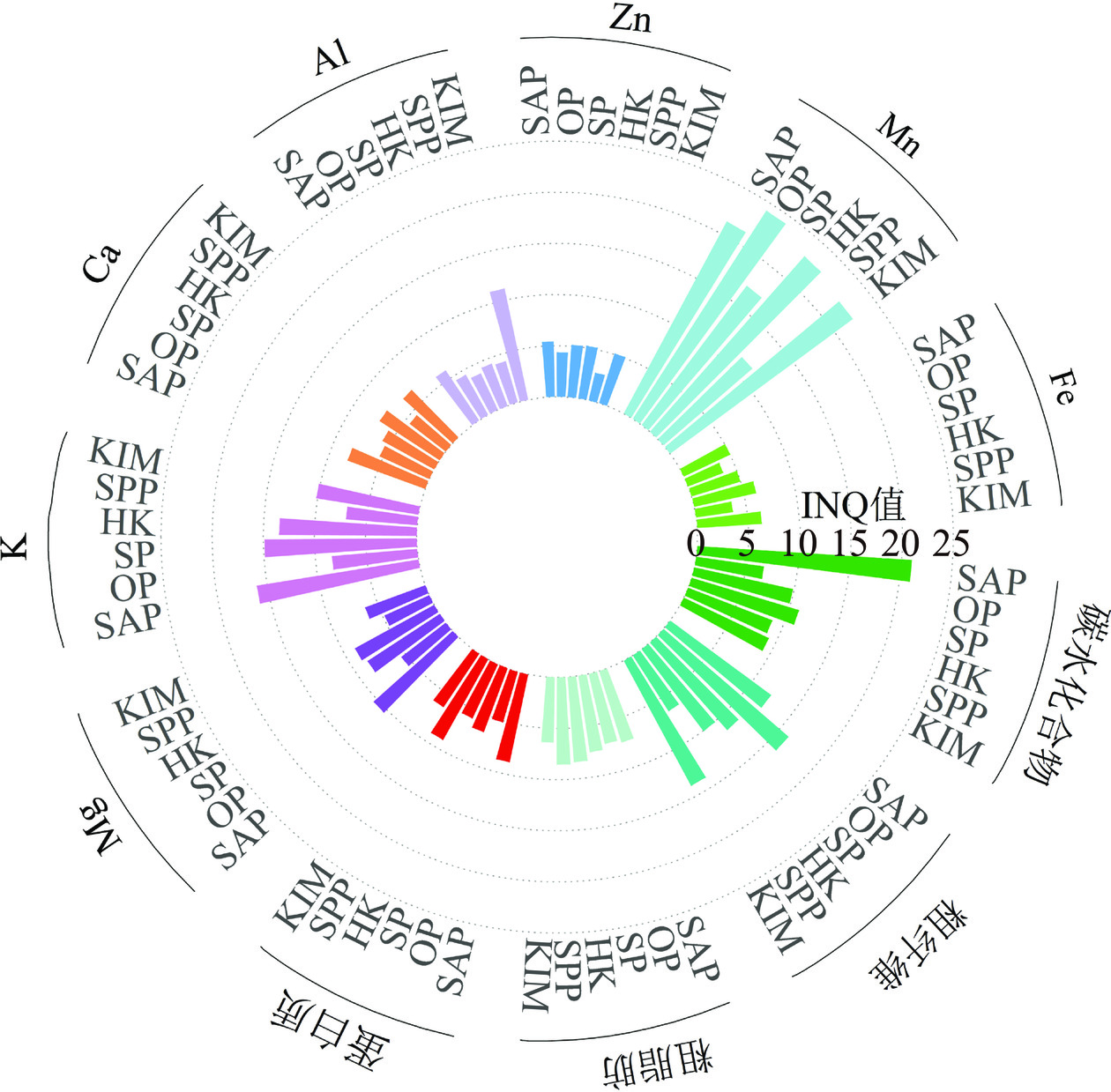Impact of Various Pickling Techniques on the Processing Quality of Cassava Tender Shoots
-
摘要: 本研究以木薯嫩梢(Cassava tender shoots,CTS)为对象,利用感官评价法、营养质量指数法(Index of nutritional quality,INQ)和主成分分析法(Principal component analysis,PCA),探究了传统泡菜、芽菜、酱菜、橄榄菜、烫泡菜和盐渍菜等制作工艺对CTS腌制菜基本化学和元素组成、抗营养因子和亚硝酸盐含量的差异,以筛选出CTS适合的腌制菜工艺。结果表明:腌制的不同工艺条件显著影响CTS腌制菜品质。其中,CTS芽菜蛋白质含量最高,为35.29 g/100 g;CTS盐渍菜大部分化学组成含量较低;CTS腌制菜所含的矿物质皆不同程度降低,其中CTS芽菜工艺减少最多(Mn、Zn、K和Mg含量分别减少71.91%、70.72%、59.20%和60.84%)。各CTS腌制菜氰化物含量在32.62~82.41 mg/kg;单宁含量较低,含量在1.07~2.33 g单宁酸/100 g;亚硝酸盐含量远低于国家标准,含量在0.37~1.02 mg/kg。感官评价表明,CTS泡菜具有较好鲜味、质感和品相等,大众认可度高;INQ评价结果显示CTS盐渍菜、CTS泡菜和CTS烫泡菜的营养价值较高;PCA发现前3个主成分的累计贡献率为83.949%,PCA综合得分结果显示,CTS泡菜、CTS橄榄菜和CTS烫泡菜综合分值较高。最后,综合感官评价、INQ评价和PCA分析评价结果,得出CTS腌制的最佳工艺为CTS泡菜制作工艺,其次是CTS烫泡菜和CTS盐渍菜制作工艺。Abstract: This study explored the differences in the chemical and elemental composition, anti-nutritional factors, and nitrate content of cassava tender shoots (CTS) pickled vegetables under various traditional processes, such as Kimchi (KIM), sprouts pickles (SPP), vegetable pickled in sauce (SP), olives pickles (OP), hot Kimchi (HK) and salted pickles (SAP), using sensory evaluation, the index of nutritional quality (INQ), and principal component analysis (PCA). The aim was to identify the optimal process for producing high-quality CTS pickled vegetables. Results indicated that different pickling processes significantly affect the quality of CTS pickled vegetables. SPP had the highest protein content at 35.29 g/100 g, while SAP had relatively lower chemical composition. The mineral content in the CTS pickled vegetables decreased to varying degrees, with SPP having the most significant decrease (71.91% in Mn content, 70.72% in Zn, 59.20% in K, and 60.84% in Mg). The cyanide content of CTS pickled vegetables ranged from 32.62 mg/kg to 82.41 mg/kg, while tannin content ranged from 1.07 g tannic acid/100 g to 2.33 g tannic acid/100 g, with nitrate content lower than the national standard at 0.37 mg/kg to 1.02 mg/kg. Sensory evaluation showed that KIM had satisfactory freshness, texture, and appearance, ranking the highest among all. INQ evaluation indicated that SAP, KIM, and HK had higher nutritional value. PCA analysis showed that the cumulative contribution rate of the first three principal components was 83.949%, and the overall score showed that KIM, OP and HK had higher quality. After comprehensive evaluation of sensory evaluation, INQ evaluation, and PCA analysis, KIM using the pickle-making process was determined to be the best method, followed by HK and SAP.
-
木薯(Manihot esculenta Crantz)也叫树薯,是世界三大薯类作物之一,主要发源于南美洲热带地区的亚马逊河流域。因其具有耐贫、耐瘠、粗管粗放、栽培技术易掌握、生产成本低等特点被广泛种植在地球南北纬30°之间的亚、非、美洲等100多个国家及地区[1]。木薯叶是木薯的主要副产物,木薯叶富含蛋白质(17.7%~38.1%,DW)、矿物质(P、K、Ca和Mg等)、维生素(维生素B1、B2、C和类胡萝卜素等)[2],营养价值与生菜、西兰花等大多数蔬菜相媲美[3],是蔬菜的良好替代来源。但由于木薯叶氰化物含量较高,约是木薯块根的5~20倍[4],对其食品开发影响很大。因此如何有效去除木薯叶抗营养因子,是其食品化发展的关键因素。
研究表明,腌制发酵能有效减低木薯叶抗营养因子水平[5]。蔬菜在腌制发酵过程中发生的生物化学反应(如碳水化合物、蛋白质和脂肪代谢等)不仅能延长蔬菜的贮存期、赋予其一系列香气、风味和质地,还能降低氰化物、单宁等有害物质[6−7]。中国腌制菜历史悠久、工艺种类繁多,主要分为几大类:泡菜类、盐渍菜类和酱腌菜类等,各大类又可细分出小类,而不同的腌制工艺,材料的选择不同,风味差异也不同[8]。
在木薯嫩梢(Cassava tender shoots,CTS)腌制产品中,人们常通过添加不同辅料和改变CTS腌制加工方式,制成不同的腌制菜。如拉丁美洲的Maniçoba,是用切碎或磨碎的甜CTS在水中与肉、猪油和香料一起煮熟,腌制5 d或更长时间后食用[9];印度尼西亚的Tumis daun singkong,是将蒸好的CTS放入混合好的材料中(炒好的Daun jeruk purut、月桂叶和Daun serai等),快速搅拌,装管密封腌制[10]。在我国,除了少数人将CTS用于制作饮料、打粉和膨化食品[11−12]外,大多数被用于动物饲料[13],且尚未发现有研究人员对其进行腌制产品开发,或是只有居民自家腌制自家食用,未流通于市场且未形成完整营养评价体系,因此CTS腌制菜的国内市场前景广阔,有很高的研发价值。
为此,本研究以木薯嫩梢为原材料,选择常见的腌制菜制作工艺,对比不同腌制工艺对CTS腌制菜的基本化学组成、矿物质元素、氰化物等抗营养因子含量和感官等品质差异,综合确定适宜CTS的腌制工艺,为CTS的食品化利用提供参考。
1. 材料与方法
1.1 材料与仪器
华南9号木薯嫩梢(CTS) 2021年10月采收于中国热带农业科学院热带作物品种资源研究所国家木薯种质圃;花椒、八角和五香粉等调味品为市售食品级 购买于武汉小丑调味品有限公司;纤维分析滤袋 北京正方兴达科技发展有限公司;乙腈、甲醇 色谱纯,购买于美国Sigma公司;福林酚 购买于上海源翘生物科技有限公司;β-巯基乙醇 购买于上海麦克林生化科技股份有限公司;BCA蛋白浓度试剂盒 购买于上海碧云天生物技术有限公司;亚硝酸盐试剂盒 购买于苏州格锐思生物科技有限公司;PVP、石油醚、氢氧化钠、无水乙醇等常规试剂 购买于海口海道森科技有限公司;没食子酸(AR) 购买于天津市大茂化学试剂厂;Fe、Mn、Zn、Al、Ca、K、Mg、Se、As和Pb标准品 购买于坛墨质检标准物质中心。
AS220.R2电子天平 购买于苏州培科实验室仪器科技有限公司;Elix3+Synergy超纯水系统 购买于美国Millipore公司;FD115烘箱 购买于德国BINDER公司;KQ-6000DE型数控超声波清洗器 购买于昆山市超声仪器有限公司;Tecan/Spark 10M酶标仪 购买于建发(广州)有限公司;iCAP PRO电感耦合等离子体发射光谱仪 购买于赛默飞世尔科技公司;IKA C 6000 isoperibol Package氧弹热量仪 购买于德国IKA公司。
1.2 实验方法
1.2.1 CTS腌制菜加工方法
处理1:参照泡菜腌制工艺[14],简称KIM(Kimchi with cassava tender shoots),即此工艺为不加香辛料的低盐泡菜工艺,将新鲜CTS清洗晾干后装入罐中,倒入配好的盐溶液没过CTS,密封腌制30 d。
处理2:参照芽菜腌制工艺[15],简称SPP(Sprouts pickles with cassava tender shoots),即芽菜经过切菜、配料、搅拌、浇糖、密封、后熟等多道工序加工而成。新鲜CTS切碎,与盐、大料、花椒、五香粉搅拌混匀入罐。白砂糖加少量水迅速搅拌熬煮至拉丝,趁热浇入灌中,混合均匀后密封30 d。
处理3:参照烫泡菜腌制工艺[16],简称HK(Hot kimchi with cassava tender shoots),即结合泡菜和酱菜工艺将盐和橄榄酱混合均匀配成泡菜水溶液。新鲜CTS烫漂1 min,捞起沥干晾凉,浸泡于泡菜水溶液中,密封发酵30 d。
处理4:参照酱渍菜腌制工艺,简称SP(Vegetables pickled in sauce with cassava tender shoots),即根据NT/T 437-2012《绿色食品 酱腌菜》定义,酱菜经过切菜、配料、酱制等多道工序加工而成。新鲜CTS切碎,与盐和橄榄酱混合均匀后酱制30 d(酱制期间搅拌1次)。
处理5:参照橄榄菜腌制工艺[17],简称OP(Olives pickles with cassava tender shoots),即新鲜CTS加入适量食盐揉搓后,放入罐中腌制30 d。腌制结束后捞起,与油熬制过夜的橄榄混合均匀(添加量为腌制结束的CTS的一半)。
处理6:参照盐渍菜腌制工艺[18],简称SAP(Salt pickles with cassava tender shoots),即采用干态盐渍方式,即将CTS洗净晾干,按一层CTS一层食盐的方法装入罐中30 d。
不同CTS腌制菜配料配比如表1。将发酵好的CTS腌制菜在恒温干燥箱中以60 ℃的条件下烘8 h,过40目筛,冷藏保存备用。
表 1 不同CTS腌制菜配料表(g)Table 1. Ingredients list of different CTS pickled vegetables (g)不同腌制菜 CTS 食盐 水 橄榄酱 白砂糖 大料 花椒 五香粉 KIM 250 20 500 SPP 1000 110 600 2.5 7.5 2.0 HK 200 4 300 80 SP 500 40 150 OP 200 10 SAP 200 过量 注:表中“过量”表示加盐量≥CTS质量。 1.2.2 化学组成测定
蛋白质含量:称取0.5000 g CTS粉样品加入10 mL 50 mmol/L的磷酸缓冲液(pH7.0,含1%PVP,0.1%巯基乙醇),以150 r/min在摇床中摇30 min,然后在12000 r/min下离心15 min,上清液用BCA蛋白试剂盒测定其溶液中可溶性氮含量,标准曲线为:y=1.2396x−0.1109;决定系数R2=0.9913。
脂肪含量:参照GB 5009.6-2016《食品中脂肪含量的测定》进行测定。
粗纤维含量:根据GB/T 8310-2013《茶粗纤维测定》,稍作修改。即将1.0000 g CTS粉装入烘干至恒重的饲料纤维滤袋并封口,分别将1 L 1.25%硫酸溶液和1 L 1.25%氢氧化钠溶液置于350 ℃的沙浴锅中煮沸,将样品放入已经沸腾的1.25%硫酸溶液中消煮30 min,取出用100 ℃蒸馏水洗涤至中性,再放入已经沸腾的1.25%氢氧化钠溶液中碱煮30 min,取出用100 ℃蒸馏水洗涤至中性,105 ℃烘至恒重。样品粗纤维含量表示为酸碱消化后恒重的样品质量与1.0000 g样品的比值。
水分含量:参照GB 5009.3-2016《食品中水分含量的测定》进行测定。
热量:氧弹法测量,利用氧弹热量仪直接测量[19]。
灰分含量:参照GB 5009.4-2016《食品中灰分含量的测定》进行测定。
碳水化合物含量:采用差减法,碳水化物(%)=100−(蛋白质+脂肪+水分+灰分+粗纤维)。
1.2.3 矿物质元素的测定
用ICP-OES法[20]测定不同腌制工艺Fe、Mn、Zn、Al、Ca、K、Mg、Se、As和Pb的含量。即称取0.3 g CTS粉末到消解管,再移取8 mL浓硝酸进行预消解(100 ℃,60 min),转移到微波消解仪上1200 W消解(阶段一:800 W、120 ℃、10 min;阶段二:1000 W、150 ℃、10 min;阶段三:1200 W、180 ℃、20 min),再放入预消解仪器中(150 ℃,1 h)进行赶酸。将消解完的溶液转移到50 mL玻璃试管中,定容(超纯水)到50 mL。过0.22 μm膜,上机测定,以标准样品为对照计算得出CTS腌制菜元素含量。ICP-OES仪器工作参数:射频功率:1150 W;载气流量:0.55 L/min;辅助气体流量:0.50 L/min;冷却气流量:12.5 L/min;泵速:45 r/min;模式:Aqueous;波长范围:iFR;等离子体观测:Axial;曝光时间:15 s;清洗时间:10 s;吸样时间:50 s。
计算公式如下:
X=(ρX−ρO)×V×f10×m 式中:X为CTS中各元素含量,mg/100 g;ρX为CTS样品的质量浓度,mg/L;ρO为空白对照质量浓度,mg/L;V为样品定容体积,mL;f为稀释倍数;m为样品质量,g。
1.2.4 抗营养因子测定
氰化物含量:参照GB 5009.36-2016《食品中氰化物含量的测定》进行测定。
单宁含量:参考宋超等[21]使用的福林-酚比色法测定,并稍作修改。称取0.2000 g CTS粉末,用60%乙醇、1:50(g/mL)料液比、超声频率300 W的条件下,50 ℃提取40 min。过滤,用60%乙醇定容至25 mL,取0.5 mL提取液,依次加入蒸馏水5 mL,Folin-Ciocalteu试剂1 mL,7.5% Na2CO3 mL,用蒸馏水定容至10 mL,在40 ℃下显色1 h,735 nm测定OD值。以10 mL反应体系中没食子酸的浓度为横坐标、波长735 nm下的吸光值为纵坐标,标准曲线的回归方程为:y=312.51x−16.074,决定系数R2=0.9997。
1.2.5 亚硝酸盐含量测定
根据亚硝酸盐与对氨基苯磺酸重氮化后,再与盐酸萘乙二胺耦合形成紫红色染料的原理,利用亚硝酸盐试剂盒测定CTS腌制菜中亚硝酸盐含量。
1.2.6 感官评价
为尽可能确保感官结果的客观性,参考孙灵霞等[22]方法稍作修改,在各行业共选取61名无视觉、嗅觉、味觉缺失且能区分指标性能差别程度和具备有对关键感官性质进行描述的能力的感官评定人员,对各工艺CTS腌制菜进行感官评价,对腌菜的形态、色泽、异物、颜色、气味、气味程度、鲜味、回味、质地、质感10项指标进行打分,并要求每次评定前需清水漱口,感官评价标准见表2。
表 2 感官指标评分标准Table 2. Sensory evaluation standard评定指标 评定标准 满意程度 形态 叶子形态完整状况 非常满意(5分)
比较满意(4分)
一般满意(3分)
稍难满意(2分)
较难满意(1分)
不满意(0)色泽 颜色清亮,酱色带黄,有光泽 异物 无明显杂物异物(如入口颗粒感等) 颜色 金黄色,无白色霉菌 气味 具有蔬菜清香和腌渍香,无刺鼻不良气味 气味程度 清香、酸香浓厚程度 鲜味 有酸香味,鲜味层次丰富不单调 回味 有蔬菜回甜,无苦味、涩味 质地 质地脆嫩,不硬不柴 质感 软嫩滑爽 1.2.7 食物营养质量指数(Index of nutritional quality,INQ)评价
将CTS腌制菜中营养素含量结合该食物所能够提供的能量来进行综合判断营养质量的优劣,公式如下:
INQ=食物中某营养素密度食物热量密度 式中:营养素密度为营养素含量/每日所需该营养素量;热量密度为热量含量/每日所需热量。
1.3 数据处理
文章采用Origin 2021绘图,IBM SPSS Statistics 27软件进行单因素、方差和主成分等分析。每项测定指标均设三次生物学重复。
2. 结果与分析
2.1 制作工艺对CTS腌制菜基本化学组成的影响
为比较不同工艺基本化学组成的差异,对不同制作工艺CTS腌制菜的基本化学组成进行测定如表3所示。OP的脂肪、粗纤维和热量含量皆为最高,分别为14.93、15.09 g/100 g和16.98 kJ/g,这是由于OP工艺是用木薯嫩梢和油熬制过夜的橄榄一同炒制而成的,橄榄中含有大量的不饱和脂肪酸(75%~88%),同时富含一些独特的油脂伴随物[23],使得OP的脂肪和热量很高。而OP粗纤维含量较高,为15.09 g/100 g,可能是橄榄是在木薯嫩梢发酵完成后才加入的,使其纤维并未被微生物所利用而导致的。SAP脂肪、蛋白质和热量含量最低,分别为:8.27、23.81 g/100 g和9.03 kJ/g;碳水化合物含量最高,为54.60 g/100 g,这可能是因为SAP工艺中加入的盐是所有工艺中含量最高的,高盐环境相比低盐环境更容易形成渗透系统,随着发酵时间的延长,营养物质会逐渐渗透到卤水中,这和刘大群等[24]的结论一致。而SPP工艺中粗纤维和碳水化合物含量较低,分别为4.66、33.09 g/100 g,蛋白质含量最高,为35.29 g/100 g,这是因为SPP工艺的辅料是所有工艺中最丰富的,蛋白质含量为所有物质的总和,有研究[25]表明SPP工艺中纤维素会在微生物和纤维素酶作用下分解为还原糖导致粗纤维含量较低。综上所述,不同工艺对CTS腌制菜的营养品质有显著影响,OP有较高的脂肪、粗纤维和热量含量,SAP大部分化学组成含量较低,SPP为高蛋白腌制菜,KIM、HK和SP各品质含量适中但也存在显著性差异。
表 3 不同腌制工艺CTS腌制菜化学组成(干物质,DW)Table 3. Chemical composition of different pickled technology of CTS pickled vegetables (dry matter, DW)不同产品 粗脂肪
(g/100 g)粗纤维
(g/100 g)蛋白质
(g/100 g)热量
(kJ/g)水分
(%)灰分(g/100 g) 碳水化合物(g/100 g) KIM 12.13±0.2b 11.64±5.62ab 28.69±1.77b 15.21±0.59ab 6.89±0.26c 0.3078±0.0302a 40.31±7.88bc SPP 13.88±0.43ab 4.66±0.85c 35.29±1.26a 13.01±0.67b 12.79±0.28a 0.362±0.1153a 33.09±2.93c HK 14.28±1.06ab 7.57±4.27bc 23.99±0.76d 13.67±2.08b 10.73±0.11b 0.3009±0.0124a 43.14±6.22b SP 13.1±0.35ab 8.72±2.7bc 27.67±1.3bc 13.86±1.79b 10.8±0.45b 0.301±0.0112a 39.42±4.81bc OP 14.93±2.65a 15.09±0.47a 26.32±0.86c 16.98±0.87a 10.64±0.78b 0.3403±0.0232a 32.69±4.79c SAP 8.27±0.32c 6.1±0.94bc 23.81±0.62d 9.03±0.47c 6.91±0.11c 0.366±0.1116a 54.6±2.1a 注:不同小写字母表示不同工艺间各组分显著性差异(P<0.05);表4同。 2.2 制作工艺对CTS腌制菜矿物质含量的影响
为对比不同工艺矿物质元素含量,对不同制作工艺CTS腌制菜的元素进行测定(表4)。结果显示,各CTS腌制菜均未检测出Se元素以及Pb和As有害元素。不同工艺腌制菜中,KIM中Fe、Al、Ca元素含量最高,分别为7.71、28.83和396.2 mg/100 g;HK含有较高的Mg元素和适中的K、Fe和Zn元素,分别为199.69、1840.12、6.79和3.57 mg/100 g。SAP和SPP中大部分元素含量相对较低。CTS经过不同腌制工艺加工后,绝大部分元素含量皆有不同程度下降,Mn、Zn、K和Mg含量下降最明显,且SPP减少最多,分别下降了71.91%、70.72%、59.20%和60.84%。出现这一现象,主要是因为不同腌制工艺原料种类和配比以及工艺流程不同使得微生物生长的营养环境差异大,造成不同工艺间微生物丰富度差异大,而微生物组成和元素含量成正相关[26]。综上所述,KIM工艺能最大程度防止矿物质元素的减少,其次是HK工艺,而SPP工艺会造成矿物质元素的大量减少。
表 4 不同腌制工艺CTS腌制菜元素含量(mg/100 g)Table 4. Element content of CTS pickled vegetables by different pickled technology (mg/100 g)不同产品 Fe Mn Zn Al Ca K Mg FL 6.09±0.44c 11.98±0.12a 6.21±0.5a 4.11±0.81d 391.92±2.22ab 2229.76±14.85a 264.38±1.22a KIM 7.71±0.16a 7.6±0.08c 3.88±0.24b 28.83±0.73a 396.2±3.14a 1542.03±17.49d 157.65±1.28d SPP 3.81±0.37e 3.37±0.03g 1.82±0.15d 9.33±2.49c 232.85±7.59f 909.59±28.22f 103.55±2.31e HK 6.79±0.41b 7.04±0.05d 3.57±0.19b 10.29±0.4c 384.05±1.23b 1840.12±8.75c 199.69±2.06b SP 5.56±0.08cd 5.32±0.14e 3.56±0.26b 9.33±1.15c 320.34±7.82d 2063.68±30.53b 192.77±4.15c OP 5.04±0.35d 9.25±0.03b 3.7±0.42b 13.01±0.78b 362.73±3.94c 1422.45±6.33e 154.14±1.19d SAP 3.63±0.17e 4.33±0.07f 2.44±0.17c 9.07±0.33c 292.86±6.33e 1448.28±22.99e 155.08±2.59d 注:其中FL表示新鲜CTS。 2.3 制作工艺对CTS腌制菜抗营养因子含量的影响
为考察各工艺抗营养指标是否符合国家标准,对各工艺CTS腌制菜的抗营养成分进行测定(图1)。
![]() 图 1 不同腌制工艺CTS腌制菜抗营养成分注:不同小写字母表示不同工艺间各组分显著性差异(P<0.05);图2同。Figure 1. Antinutritional constituents of CTS pickled vegetables by different pickled technology
图 1 不同腌制工艺CTS腌制菜抗营养成分注:不同小写字母表示不同工艺间各组分显著性差异(P<0.05);图2同。Figure 1. Antinutritional constituents of CTS pickled vegetables by different pickled technologyCTS腌制菜中(图1a)SAP氰化物含量最高,为82.41 mg/kg,OP氰化物含量最低,为32.62 mg/kg。除SPP和HK无显著差异外(P>0.05),其他工艺均表现出差异性(P<0.05),表明不同预处理对CTS腌制菜氰化物水平有显著影响。其中OP、KIM和HK在发酵期间处理方式相似且含量相对较低,说明泡菜工艺更适合降低氰化物含量。而OP氰化物水平最低可能是因为它在泡菜工艺基础上加入了热油熬制的橄榄,高温能使氰化物含量降低。但所有工艺氰化物含量都高于FAO所规定的10 mg/kg,高水平氰化物含量会严重影响人体的健康[27]。因此CTS腌制菜应在传统工艺基础上增加脱氢处理流程,如在腌制前增加蒸、煮等步骤以降低原材料的氰化物含量[28],或经过家庭烹饪后食用(如以炒制为例:锅中加入少许食用油,油热下CTS腌制菜,中小火炒制10 min,氰化物含量能降至0.0595±0.0381 mg/kg)。
CTS中的单宁主要以缩合单宁形式存在(花青素和海藻素等),当它们与唾液蛋白质形成复合物时,能使蛋白酶失活、造成食品的涩味和苦味[29]。CTS腌制菜中(图1b)OP单宁含量最高,为2.33 g单宁酸/100 g,SPP和SAP含量最低,分别为1.07 g单宁酸/100 g、1.23 g单宁酸/100 g。结果表明SPP工艺对单宁的减少最有效,其次是SAP工艺、HK工艺、SP工艺、KIM工艺和OP工艺,但各工艺单宁含量均较低,对CTS腌制菜风味影响较小。综上所述,各CTS腌制菜氰化物含量高于FAO标准,烹饪后能安全食用;不同工艺对单宁含量的减少有显著影响,但都能降低至较低水平,对食品风味影响较小。
2.4 制作工艺对CTS腌制菜亚硝酸盐含量的影响
亚硝酸盐是一种对人体有害的物质,在腌制过程中累积的硝酸盐会在硝酸还原酶的作用下被大量转化为亚硝酸盐,食入人体后会引起组织缺氧甚至诱发消化系统癌变[30]。因此检测CTS发酵制品的亚硝酸盐含量非常有必要,如图2。
从图中可以看出SP亚硝酸盐含量最高,为1.02 mg/kg;KIM亚硝酸盐含量最低,为0.37 mg/kg。有研究表明,泡菜工艺环境更适宜乳酸菌生长,能产生更多的亚硝酸盐降解酶,从而迅速降解亚硝酸盐[31],这也解释了KIM亚硝酸盐含量处于较低水平。HK属于泡菜衍生工艺,因此其亚硝酸盐含量也相对较低,略高于SPP,但都远低于《食品安全国家标准 食品中污染物限量》GB 2762-2017/XG1-2021中的规定(腌渍蔬菜中亚硝酸盐(以NaNO2计)的含量应≤20 mg/kg)。结果表明,KIM工艺拥有更高的亚硝酸盐降解能力,其次是SPP工艺、HK工艺、OP工艺、SAP工艺和SP工艺,且都符合国家安全标准。
2.5 感官评价
为对比各工艺口感差异,对不同制作工艺CTS腌制菜进行感官评价分析,各指标取其平均数,结果如图3所示。各CTS腌制菜综合评分由高到低分别为KIM、SP、SPP、SAP、OP和HK。KIM拥有较低的异物感,同时具有较好的颜色色泽以及最高的鲜味指标最容易被大众所认可。OP有较高的鲜味和质地以及适中的颜色和气味程度,这是因为OP的高纤维含量能赋予腌菜丰富的质地口感,而加入用油炒香的橄榄能让其鲜味层次感更加突出。OP的气味、回味等感官评价分最低,结合单宁含量分析,可能是因为OP单宁含量最高影响了其风味的形成。HK由于其较低的回味、鲜味以及较高的异物感使得综合评分最低。
2.6 INQ评价
人体所必需的营养素有蛋白质、脂肪、无机盐(矿物质)和纤维等。因此对CTS腌制菜营养评价必需准确客观,不单以含量的多少评价其价值。INQ法表示人体从某食物获得足够热量时,从该食物获得的营养素是否能满足人体所需。某营养素INQ值越高表示该营养素营养价值越高。由图4可知,几种CTS腌制菜工艺中,Mn元素营养价值由高到低分别为OP、HK、KIM、SAP、SP和SPP;Fe元素营养价值由高到低分别为KIM、HK、SAP、SP、OP和SPP;Mg元素营养价值由高到低分别为SAP、HK、SP、KIM、OP和SPP;K元素营养价值由高到低分别为SAP、SP、HK、KIM、OP和SPP;Ca元素营养价值由高到低分别为SAP、HK、KIM、SP、OP和SPP;Al元素营养价值由高到低分别为KIM、SAP、OP、HK、SPP和SP;Zn元素营养价值由高到低分别为SAP、HK、SP、KIM、OP和SPP;蛋白质营养价值由高到低分别为SPP、SAP、SP、KIM、HK和OP;脂肪营养价值由高到低分别为SPP、HK、SP、SAP、OP和KIM;粗纤维营养价值由高到低分别为OP、KIM、SAP、SP、HK和SPP;碳水化合物营养价值由高到低分别为SAP、HK、SP、KIM、SPP和OP。综上所述,脂肪、粗纤维和Mn对各CTS腌制菜的INQ影响较大,而SAP、KIM和HK的营养价值较高。
2.7 PCA分析
对6种CTS腌制菜主要成分进行PCA分析如表5。第一、二、三主成分贡献率分别为46.456%、25.354%和12.139%,这三个成分的累计贡献率达到83.949%,包含绝大部分信息量,因此取前三个特征值为主成分。
表 5 PCA特征值、贡献率、累计贡献率和载荷矩阵Table 5. PCA eigenvalue, contribution rate, cumulative contribution rate and load matrix of each element主成分 1 2 3 特征值 6.504 3.55 1.699 贡献率(%) 46.456 25.354 12.139 累计贡献率(%) 46.456 71.81 83.949 载荷矩阵 Zn 0.3745 0.0706 0.0169 Ca 0.3717 0.061 0.1849 Mn 0.36 −0.0717 −0.1036 Fe 0.3215 −0.0483 0.3307 Mg 0.2462 0.3667 −0.0123 K 0.2313 0.362 −0.0299 Al 0.2153 −0.2134 0.4941 粗纤维 0.2741 −0.1014 −0.2263 蛋白质 −0.1749 −0.4087 0.0031 碳水化合物 −0.0816 0.388 0.3268 脂肪 0.1533 −0.2744 −0.3936 氰化物 −0.2604 0.362 0.102 单宁 0.3521 −0.0149 −0.2071 亚硝酸盐 −0.0173 0.3721 −0.4841 其中,对第一主成分贡献较大的有Zn、Ca和Mn等,对第二主成分贡献率较大的有碳水化合物、亚硝酸盐和Mg等,对第三主成分贡献较大的有Al、Fe和碳水化合物等。根据主成分的载荷矩阵和特征值得到回归方程:
Y1=0.3745X1+0.3717X2+0.3600X3+0.3215X4+0.2462X5+0.2313X6+0.2153X7−0.2741X8−0.1749X9−0.0816X10+0.1533X11−0.2604X12+0.3521X13−0.0173X14
Y2=0.0706X1+0.0610X2−0.0717X3+0.0483X4+0.3667X5−0.3620X6−0.2134X7−0.1014X8−0.4087X9+0.3880X10−0.2744X11+0.3620X12−0.0149X13+0.3721X14
Y3=0.0169X1+0.1849X2−0.1036X3+0.3307X4−0.0123X5−0.0299X6+0.4941X7−0.2263X8+0.0031X9+0.3268X10−0.3936X11+0.1020X12−0.2071X13−0.4841X14
式中:X1为Zn,X2为Ca,X3为Mn,X4为Fe,X5为Mg,X6为K,X7为Al,X8为粗纤维,X9为蛋白质,X10为碳水化合物,X11为脂肪,X12为氰化物,X13为单宁,X14为亚硝酸盐。
得出各种发酵工艺CTS产品第一、二和三主成分分值,见表6。对6种CTS腌制菜进行品质的综合评价,以方差贡献率作为加权系数,建立综合评价函数Y=0.46456Y1+0.25354Y2+0.12139Y3,其中Y1、Y2和Y3是主成分分值,由此得到综合评价得分Y值[32]。可知6种CTS腌制菜工艺中KIM综合评分最高,其次为HK、OP、SP、SAP,综合评分最低是SPP。综上所述,以木薯嫩梢主要成分的PCA值为考察指标,则KIM、HK和OP的综合品质较优,这和INQ指数分析结果基本一致。
表 6 综合主成分分值Table 6. Composite principal component score第一
主成分排名 第二
主成分排名 第三
主成分排名 综合
主成分排名 KIM 2.4543 1 −1.4030 5 2.0857 1 1.0377 1 SPP −3.9594 6 −2.6301 6 −0.2315 4 −2.5343 6 HK 1.5480 3 1.0014 3 0.2652 3 1.0052 2 SP 0.4187 4 1.6397 2 −0.9388 5 0.4963 4 OP 2.2388 2 −1.0680 4 −1.8196 6 0.5484 3 SAP −2.7005 5 2.4600 1 0.6390 2 −0.5533 5 2.8 综合分析
为综合分析INQ指数得分、PCA得分和感官评价得分结果以确保筛选出的CTS腌制菜工艺更合理,采用德尔菲法[33]对各得分进行赋权打分,即INQ、PCA和感官评价的加权系数为X=〔0.276, 0.263, 0.461〕。将各得分与各加权系数相乘得出新分值(表7)。从表中能够看出不同工艺CTS腌制菜品质综合排名由高到低分别为:KIM、HK、SAP、SP、OP和SPP。说明KIM、HK和SAP从组成、营养和口感等方面相对于其他工艺更符合当下市场需求,可作为CTS腌制菜的产品研发方向。
表 7 不同工艺CTS腌制菜综合品质排名Table 7. Overall quality ranking of CTS pickled vegetables with different technology腌制菜 INQ 排名 PCA 排名 感官评价 排名 综合评分 综合排名 KIM 2.5972 2 0.2729 1 11.6218 1 14.4919 1 SPP 1.7912 6 −0.6665 6 11.5020 3 12.6267 6 HK 2.5916 3 0.2644 2 11.5803 2 14.4363 2 SP 2.4040 4 0.1305 4 11.2622 6 13.7967 4 OP 2.2853 5 0.1442 3 11.2853 5 13.7148 5 SAP 3.0526 1 −0.1455 5 11.4789 4 14.3859 3 3. 结论
本文研究了CTS腌制菜的化学和元素组成、抗营养因子和亚硝酸盐含量,并重点探究了感官评价法、INQ评价法和PCA分析对其的影响。研究发现,SPP为高蛋白腌制菜,达35.29 g/100 g(DW),SAP大部分化学组成含量较低。KIM工艺能有效地防止矿物质元素的减少;与之相反,SPP工艺会造成矿物质元素的大量减少。对CTS腌制菜的抗营养因子和亚硝酸盐含量的分析发现,各工艺氰化物含量偏高,经过炒制可达食用要求。各CTS腌制菜单宁含量均较低,其中SPP单宁含量最低,为1.07 g单宁酸/100 g;OP单宁含量最高,为2.33 g单宁酸/100 g。KIM工艺亚硝酸盐降解能力最强,其次是SPP工艺和HK工艺。对CTS腌制菜的感官评价研究发现,OP高单宁含量会影响其风味形成使其感官评分较低,而KIM因鲜味、质感和品相等优良最受大众喜爱。在INQ评价和PCA分析中,SAP、KIM和HK表现出较高的INQ值,说明它们营养素种类相对较丰富更能满足人们日常营养需求,KIM、OP和HK的PCA综合得分最高。
综合感官评价、INQ评价和PCA分析评价的结果表明,KIM、HK和SAP的工艺不仅符合大众口味,而且营养价值高,可做为CTS腌制菜的加工发展方向。但其他各CTS腌制菜也符合当下市场需求,如SAP的INQ值最高;OP有较高的鲜味和质地;SPP蛋白质含量高。因此在重点推广KIM、HK和SAP的同时,可以针对不同营养需求和不同口感喜好的人群推广相应的CTS腌制菜。
-
图 1 不同腌制工艺CTS腌制菜抗营养成分
注:不同小写字母表示不同工艺间各组分显著性差异(P<0.05);图2同。
Figure 1. Antinutritional constituents of CTS pickled vegetables by different pickled technology
表 1 不同CTS腌制菜配料表(g)
Table 1 Ingredients list of different CTS pickled vegetables (g)
不同腌制菜 CTS 食盐 水 橄榄酱 白砂糖 大料 花椒 五香粉 KIM 250 20 500 SPP 1000 110 600 2.5 7.5 2.0 HK 200 4 300 80 SP 500 40 150 OP 200 10 SAP 200 过量 注:表中“过量”表示加盐量≥CTS质量。 表 2 感官指标评分标准
Table 2 Sensory evaluation standard
评定指标 评定标准 满意程度 形态 叶子形态完整状况 非常满意(5分)
比较满意(4分)
一般满意(3分)
稍难满意(2分)
较难满意(1分)
不满意(0)色泽 颜色清亮,酱色带黄,有光泽 异物 无明显杂物异物(如入口颗粒感等) 颜色 金黄色,无白色霉菌 气味 具有蔬菜清香和腌渍香,无刺鼻不良气味 气味程度 清香、酸香浓厚程度 鲜味 有酸香味,鲜味层次丰富不单调 回味 有蔬菜回甜,无苦味、涩味 质地 质地脆嫩,不硬不柴 质感 软嫩滑爽 表 3 不同腌制工艺CTS腌制菜化学组成(干物质,DW)
Table 3 Chemical composition of different pickled technology of CTS pickled vegetables (dry matter, DW)
不同产品 粗脂肪
(g/100 g)粗纤维
(g/100 g)蛋白质
(g/100 g)热量
(kJ/g)水分
(%)灰分(g/100 g) 碳水化合物(g/100 g) KIM 12.13±0.2b 11.64±5.62ab 28.69±1.77b 15.21±0.59ab 6.89±0.26c 0.3078±0.0302a 40.31±7.88bc SPP 13.88±0.43ab 4.66±0.85c 35.29±1.26a 13.01±0.67b 12.79±0.28a 0.362±0.1153a 33.09±2.93c HK 14.28±1.06ab 7.57±4.27bc 23.99±0.76d 13.67±2.08b 10.73±0.11b 0.3009±0.0124a 43.14±6.22b SP 13.1±0.35ab 8.72±2.7bc 27.67±1.3bc 13.86±1.79b 10.8±0.45b 0.301±0.0112a 39.42±4.81bc OP 14.93±2.65a 15.09±0.47a 26.32±0.86c 16.98±0.87a 10.64±0.78b 0.3403±0.0232a 32.69±4.79c SAP 8.27±0.32c 6.1±0.94bc 23.81±0.62d 9.03±0.47c 6.91±0.11c 0.366±0.1116a 54.6±2.1a 注:不同小写字母表示不同工艺间各组分显著性差异(P<0.05);表4同。 表 4 不同腌制工艺CTS腌制菜元素含量(mg/100 g)
Table 4 Element content of CTS pickled vegetables by different pickled technology (mg/100 g)
不同产品 Fe Mn Zn Al Ca K Mg FL 6.09±0.44c 11.98±0.12a 6.21±0.5a 4.11±0.81d 391.92±2.22ab 2229.76±14.85a 264.38±1.22a KIM 7.71±0.16a 7.6±0.08c 3.88±0.24b 28.83±0.73a 396.2±3.14a 1542.03±17.49d 157.65±1.28d SPP 3.81±0.37e 3.37±0.03g 1.82±0.15d 9.33±2.49c 232.85±7.59f 909.59±28.22f 103.55±2.31e HK 6.79±0.41b 7.04±0.05d 3.57±0.19b 10.29±0.4c 384.05±1.23b 1840.12±8.75c 199.69±2.06b SP 5.56±0.08cd 5.32±0.14e 3.56±0.26b 9.33±1.15c 320.34±7.82d 2063.68±30.53b 192.77±4.15c OP 5.04±0.35d 9.25±0.03b 3.7±0.42b 13.01±0.78b 362.73±3.94c 1422.45±6.33e 154.14±1.19d SAP 3.63±0.17e 4.33±0.07f 2.44±0.17c 9.07±0.33c 292.86±6.33e 1448.28±22.99e 155.08±2.59d 注:其中FL表示新鲜CTS。 表 5 PCA特征值、贡献率、累计贡献率和载荷矩阵
Table 5 PCA eigenvalue, contribution rate, cumulative contribution rate and load matrix of each element
主成分 1 2 3 特征值 6.504 3.55 1.699 贡献率(%) 46.456 25.354 12.139 累计贡献率(%) 46.456 71.81 83.949 载荷矩阵 Zn 0.3745 0.0706 0.0169 Ca 0.3717 0.061 0.1849 Mn 0.36 −0.0717 −0.1036 Fe 0.3215 −0.0483 0.3307 Mg 0.2462 0.3667 −0.0123 K 0.2313 0.362 −0.0299 Al 0.2153 −0.2134 0.4941 粗纤维 0.2741 −0.1014 −0.2263 蛋白质 −0.1749 −0.4087 0.0031 碳水化合物 −0.0816 0.388 0.3268 脂肪 0.1533 −0.2744 −0.3936 氰化物 −0.2604 0.362 0.102 单宁 0.3521 −0.0149 −0.2071 亚硝酸盐 −0.0173 0.3721 −0.4841 表 6 综合主成分分值
Table 6 Composite principal component score
第一
主成分排名 第二
主成分排名 第三
主成分排名 综合
主成分排名 KIM 2.4543 1 −1.4030 5 2.0857 1 1.0377 1 SPP −3.9594 6 −2.6301 6 −0.2315 4 −2.5343 6 HK 1.5480 3 1.0014 3 0.2652 3 1.0052 2 SP 0.4187 4 1.6397 2 −0.9388 5 0.4963 4 OP 2.2388 2 −1.0680 4 −1.8196 6 0.5484 3 SAP −2.7005 5 2.4600 1 0.6390 2 −0.5533 5 表 7 不同工艺CTS腌制菜综合品质排名
Table 7 Overall quality ranking of CTS pickled vegetables with different technology
腌制菜 INQ 排名 PCA 排名 感官评价 排名 综合评分 综合排名 KIM 2.5972 2 0.2729 1 11.6218 1 14.4919 1 SPP 1.7912 6 −0.6665 6 11.5020 3 12.6267 6 HK 2.5916 3 0.2644 2 11.5803 2 14.4363 2 SP 2.4040 4 0.1305 4 11.2622 6 13.7967 4 OP 2.2853 5 0.1442 3 11.2853 5 13.7148 5 SAP 3.0526 1 −0.1455 5 11.4789 4 14.3859 3 -
[1] OPABODE B. Responses of cassava (Manihot esculenta Crantz) cultivars to in wfro-induced phosphorus stress[J]. Journal of Crop Improvement,2019,33(1):53−56. doi: 10.1080/15427528.2018.1542365
[2] CHAIAREEKITWAT S, LATIF S, MAHAYOTHEE B, et al. Protein composition, chlorophyll, carotenoids, and cyanide content of cassava leaves (Manihot esculenta Crantz) as influenced by cultivar, plant age, and leaf position[J]. Food Chemistry,2022,372:131173. doi: 10.1016/j.foodchem.2021.131173
[3] DA SILVA SANTOS B R, REQUIÃO SILVA E F, MINHO L A C, et al. Evaluation of the nutritional composition in effect of processing cassava leaves (Manihot esculenta) using multivariate analysis techniques[J]. Microchemical Journal,2020,152:104271. doi: 10.1016/j.microc.2019.104271
[4] JAMIL S S, BUJANG A. Nutrient and antinutrient composition of different variety of cassava (Manihot esculenta Crantz) leaves[J]. Jurnal Teknologi,2016,78(6):59−63.
[5] TEREFE Z K, OMWAMBA M, NDUKO J M. Effect of microbial fermentation on nutritional and antinutritional contents of cassava leaf[J]. Journal of Food Safety,2022,42(3):e12969. doi: 10.1111/jfs.12969
[6] OKOTH R A, MATOFARI J W, NDUKO J M. Effectiveness of Levilactobacillus brevis fermentation on antinutrients and protein quality of leaves of selected cassava varieties[J]. Applied Food Research,2022,2(2):100134. doi: 10.1016/j.afres.2022.100134
[7] 花蕴, 黄昆仑, 梁志宏. 微生物发酵法降解谷物中抗营养因子的研究进展[J]. 食品与发酵工业,2020,46(21):272−276. [HUA Y, HUANG K L, LIANG Z H. Research progress on degradation of antitrophic factors in cereals by microbial fermentation[J]. Food and Fermentation Industry,2020,46(21):272−276.] doi: 10.13995/j.cnki.11-1802/ts.024129 HUA Y, HUANG K L, LIANG Z H. Research progress on degradation of antitrophic factors in cereals by microbial fermentation[J]. Food and Fermentation Industry, 2020, 46(21): 272−276. doi: 10.13995/j.cnki.11-1802/ts.024129
[8] 张诗瑶, 孙钰薇, 刘志佳, 等. 中华传统发酵蔬菜风味轮廓及风味形成研究进展[J]. 中国食品学报,2022,22(12):373−388. [ZHANG S Y, SUN Y W, LIU Z J, et al. Research progress on flavor profile and flavor formation of traditional Chinese fermented vegetables[J]. Journal of Chinese Institute of Food Science and Technology,2022,22(12):373−388.] doi: 10.16429/j.1009-7848.2022.12.036 ZHANG S Y, SUN Y W, LIU Z J, et al. Research progress on flavor profile and flavor formation of traditional Chinese fermented vegetables[J]. Journal of Chinese Institute of Food Science and Technology, 2022, 22(12): 373−388. doi: 10.16429/j.1009-7848.2022.12.036
[9] KUBO I, MASUOKA N, NIHEI K I, et al. Manicoba, a quercetin-rich Amazonian dish[J]. Journal of Food Composition & Analysis,2006,19(6-7):579−588.
[10] HERMININGRUM S. The genealogy of traditional Javanese cassava-based foods[J]. Journal of Ethnic Foods,2019,6(1):1−16. doi: 10.1186/s42779-019-0002-x
[11] 高超. 木薯叶营养成分及其膨化食品的研究[D]. 郑州:河南工业大学, 2011. [GAO C. Study on the Nutritional composition of cassava leaf and its extruded food[D]. Zhengzhou:Henan University of Technology, 2011.] GAO C. Study on the Nutritional composition of cassava leaf and its extruded food[D]. Zhengzhou: Henan University of Technology, 2011.
[12] 刘畅. 木薯汁饮品的加工工艺研究[D]. 海口:海南大学, 2015. [LIU C. Study on processing technology of cassava juice drink[D]. Haikou:Hainan University, 2015.] LIU C. Study on processing technology of cassava juice drink[D]. Haikou: Hainan University, 2015.
[13] 曹萌萌, 杨龙, 陈松笔, 等. 不同木薯叶营养成分对饲养木薯蚕的影响[J]. 南方农业学报,2022,53(6):1759−1767. [CAO M M, YANG L, CHEN S B, et al. Effects of different cassava leaf nutrients on rearing cassava silkworm[J]. Acta Agriculturae Agriculturae Australis,2022,53(6):1759−1767.] doi: 10.3969/j.issn.2095-1191.2022.06.030 CAO M M, YANG L, CHEN S B, et al. Effects of different cassava leaf nutrients on rearing cassava silkworm[J]. Acta Agriculturae Agriculturae Australis, 2022, 53(6): 1759−1767. doi: 10.3969/j.issn.2095-1191.2022.06.030
[14] 汪铃. 传统低盐泡菜发酵体系稳定性及香辛料对其影响[D]. 镇江:江苏大学, 2022. [WANG L. The stability of traditional low-salt Kimchi fermentation system and the effect of spices on it [D]. Zhenjiang:Jiangsu University, 2022.] WANG L. The stability of traditional low-salt Kimchi fermentation system and the effect of spices on it [D]. Zhenjiang: Jiangsu University, 2022.
[15] 刘云秀. 宜宾芽菜的研制[J]. 中国调味品,2007(8):58−73. [LIU Y X. Development of Yibin sprouts[J]. Chinese Condiments,2007(8):58−73.] doi: 10.3969/j.issn.1000-9973.2007.08.013 LIU Y X. Development of Yibin sprouts[J]. Chinese Condiments, 2007(8): 58−73. doi: 10.3969/j.issn.1000-9973.2007.08.013
[16] 任亚梅, 刘兴华, 罗安伟, 等. 草石蚕泡菜罐头的研制[J]. 中国食品学报,2007(1):120−124. [REN Y M, LIU X H, LUO A W, et al. Preparation of canned Kimchi by Caoshi Silkworm[J]. Journal of Chinese Institute of Food Science and Technology,2007(1):120−124.] doi: 10.3969/j.issn.1009-7848.2007.01.022 REN Y M, LIU X H, LUO A W, et al. Preparation of canned Kimchi by Caoshi Silkworm[J]. Journal of Chinese Institute of Food Science and Technology, 2007(1): 120−124. doi: 10.3969/j.issn.1009-7848.2007.01.022
[17] 橄榄菜加工技术[J]. 农民科技培训, 2012(9):37. [Olive processing technology[J]. Farmer Science and Technology Training, 2012(9):37.] Olive processing technology[J]. Farmer Science and Technology Training, 2012(9): 37.
[18] 唐垚. 不同发酵形态盐渍萝卜发酵过程中风味物质与微生物菌群的关联性分析[D]. 雅安:四川农业大学, 2020. [TANG Y. Correlation analysis of flavor substances and microbial flora during fermentation of salted radish with different fermentation forms[D]. Ya'an:Sichuan Agricultural University, 2020.] TANG Y. Correlation analysis of flavor substances and microbial flora during fermentation of salted radish with different fermentation forms[D]. Ya'an: Sichuan Agricultural University, 2020.
[19] 曲世超, 陈溪, 黄大亮, 等. 氧弹量热仪测定食品热量[J]. 检验检疫学刊,2013,23(1):38−40. [QU S C, CHEN X, HUANG D L, et al. Determination of food calories by oxygen bomb calorimeter[J]. Journal of Inspection and Quarantine,2013,23(1):38−40.] QU S C, CHEN X, HUANG D L, et al. Determination of food calories by oxygen bomb calorimeter[J]. Journal of Inspection and Quarantine, 2013, 23(1): 38−40.
[20] 庞敏. 明日叶中七种矿物质元素含量测定及营养质量指数分析[J]. 食品与发酵工业,2020,46(20):249−253. [PANG M. Determination of seven mineral elements in leaves of tomorrow and analysis of nutrient quality index[J]. Food and Fermentation Industry,2020,46(20):249−253.] doi: 10.13995/j.cnki.11-1802/ts.024571 PANG M. Determination of seven mineral elements in leaves of tomorrow and analysis of nutrient quality index[J]. Food and Fermentation Industry, 2020, 46(20): 249−253. doi: 10.13995/j.cnki.11-1802/ts.024571
[21] 宋超, 程洪斌, 窦思远, 等. 黑柿叶中单宁提取工艺研究[J]. 现代园艺,2022,45(5):19−21. [SONG C, CHENG H B, DOU S Y, et al. Study on tannin extraction from black persimmon leaves[J]. Modern Horticulture,2022,45(5):19−21.] doi: 10.3969/j.issn.1006-4958.2022.05.007 SONG C, CHENG H B, DOU S Y, et al. Study on tannin extraction from black persimmon leaves[J]. Modern Horticulture, 2022, 45(5): 19−21. doi: 10.3969/j.issn.1006-4958.2022.05.007
[22] 孙灵霞, 詹飞丽, 潘治利, 等. 食品感官品评员对感官评价结果的影响[J]. 食品工业,2021,42(10):268−270. [SUN L X, ZHAN F L, PAN Z L, et al. Influence of food sensory evaluators on sensory evaluation results[J]. Food Industry,2021,42(10):268−270.] SUN L X, ZHAN F L, PAN Z L, et al. Influence of food sensory evaluators on sensory evaluation results[J]. Food Industry, 2021, 42(10): 268−270.
[23] 蔡静薇, 武利梅, 张玉环, 等. 橄榄油的脂肪伴随物及其健康功能特性[J]. 中国油脂,2023,48(5):78−84. [CAI J W, WU L M, ZHANG Y H, et al. Fat concomitants of olive oil and their health function characteristics[J]. China Oils and Fats,2023,48(5):78−84.] CAI J W, WU L M, ZHANG Y H, et al. Fat concomitants of olive oil and their health function characteristics[J]. China Oils and Fats, 2023, 48(5): 78−84.
[24] 刘大群, 陈文垣, 吴伟杰. 盐量对渍菜盐渍品质和微生物的影响研究[J]. 现代食品科技,2016,32(12):266−271. [LIU D Q, CHEN W Y, WU W J. Study on effects of salt content on Salting quality and microorganisms of pickled vegetables[J]. Modern Food Science and Technology,2016,32(12):266−271.] doi: 10.13982/j.mfst.1673-9078.2016.12.041 LIU D Q, CHEN W Y, WU W J. Study on effects of salt content on Salting quality and microorganisms of pickled vegetables[J]. Modern Food Science and Technology, 2016, 32(12): 266−271. doi: 10.13982/j.mfst.1673-9078.2016.12.041
[25] 杨长平, 顾思远, 孙俊秀, 等. 宜宾芽菜风味的感官鉴定与电子鼻分析的相关性研究[J]. 中国酿造,2017,36(6):59−62. [YANG C P, GU SY, SUN J X, et al. Study on correlation between sensory identification and electronic nose analysis of Yibin sprout flavor[J]. China Brewing,2017,36(6):59−62.] doi: 10.11882/j.issn.0254-5071.2017.06.012 YANG C P, GU SY, SUN J X, et al. Study on correlation between sensory identification and electronic nose analysis of Yibin sprout flavor[J]. China Brewing, 2017, 36(6): 59−62. doi: 10.11882/j.issn.0254-5071.2017.06.012
[26] MANNAA M, SEO Y, PARK I. Effect of seafood (gizzard shad) supplementation on the chemical composition and microbial dynamics of radish kimchi during fermentation[J]. Scientific Reports,2019,9(1):17963. doi: 10.1038/s41598-019-54292-x
[27] QUINN A A, MYRANS H, GLEADOW R M. Cyanide content of cassava food products available in Australia[J]. Foods,2022,11(10):1384. doi: 10.3390/foods11101384
[28] AYELE H H, LATIF S, MÜLLER J. Pretreatment of the leaves of ethiopian cassava (Manihot esculenta Crantz) varieties:Effect of blanching on the quality of dried cassava leaves[J]. Applied Sciences,2022,12(21):11231. doi: 10.3390/app122111231
[29] SHARMA K, KUMAR V, KAUR J, et al. Health effects, sources, utilization and safety of tannins: A critical review[J]. Toxin Reviews,2021,40(4):432−444. doi: 10.1080/15569543.2019.1662813
[30] 黄丽慧, 张雁, 陈于陇, 等. 发酵蔬菜中亚硝酸盐消长规律及调控技术的研究进展[J]. 食品科学,2013,34(5):303−307. [HUANG L H, ZHANG Y, CHEN Y L, et al. Research progress on the fluctuation and regulation of nitrite in fermented vegetables[J]. Food Science,2013,34(5):303−307.] HUANG L H, ZHANG Y, CHEN Y L, et al. Research progress on the fluctuation and regulation of nitrite in fermented vegetables[J]. Food Science, 2013, 34(5): 303−307.
[31] 鲜双, 姜林君, 李艳兰, 等. 不同方式发酵的哈密瓜幼果泡菜理化特性和氨基酸含量分析[J]. 食品与发酵工业, 2021, 47(5):224−230. [XIAN S, JIANG L J, LI Y L, et al. Analysis of physicochemical properties and amino acid contents of young Hami melon pickles fermented by different methods[J]. Food and Fermentation Industry, 2021, 47(5):224−230.] XIAN S, JIANG L J, LI Y L, et al. Analysis of physicochemical properties and amino acid contents of young Hami melon pickles fermented by different methods[J]. Food and Fermentation Industry, 2021, 47(5): 224−230.
[32] 刘阳, 张静, 邹伟, 等. 五种宜宾芽菜游离氨基酸含量分析研究[J]. 中国调味品,2016,41(10):112−116. [LIU Y, ZHANG J, ZOU W, et al. Analysis of free amino acids in five Yibin sprouts[J]. [J]. Chinese Condiment,2016,41(10):112−116.] doi: 10.3969/j.issn.1000-9973.2016.10.025 LIU Y, ZHANG J, ZOU W, et al. Analysis of free amino acids in five Yibin sprouts[J]. [J]. Chinese Condiment, 2016, 41(10): 112−116. doi: 10.3969/j.issn.1000-9973.2016.10.025
[33] 徐树来. 食品感官分析与实验[M]. 3版. 北京:化学工业出版社, 2020:129−130. [XU S L. Food sensory analysis and experiment[M]. 3rd Ed. Beijing:Chemical Industry Press, 2020:129−130.] XU S L. Food sensory analysis and experiment[M]. 3rd Ed. Beijing: Chemical Industry Press, 2020: 129−130.
-
期刊类型引用(2)
1. 仇晨晨,刘云,刘斌. 灰树花醇提物体外抗氧化及降血糖活性分析. 中国食用菌. 2025(01): 41-49 .  百度学术
百度学术
2. 陈雪梅,邵惠丽,高燕,郑真,邓碧琦,朱立俏,盛华刚. 不同产地玄参多糖的单糖组成及分子量测定. 天津中医药大学学报. 2024(12): 1082-1089 .  百度学术
百度学术
其他类型引用(1)





 下载:
下载:




 下载:
下载:



